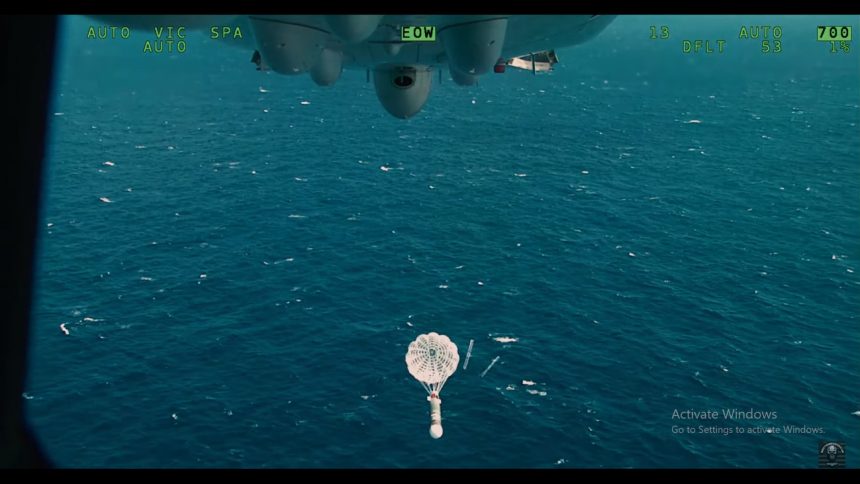The world’s largest naval exercise with participation of roughly 29 nations, 40 surface ships, three submarines, 14 national land forces, over 150 aircraft, and more than 25,000 personnel, marked the first time an Australian P-8A dropped this variant of the Mark 54 Lightweight Exercise Torpedo.
A RAAF (Royal Australian Air Force) dropped four exercise Mark 54 torpedoes from a P-8A MPA (Maritime Patrol Aircraft) last week during the RIMPAC (Rim of the Pacific) exercises. RAAF officials said this was the first time they used this variant of the weapon in the drill to “simulate destroying a submarine.”
A video showed one of the torpedoes being released and deploying a drag chute, before hitting the water. The submarine taking part in the drill was a USN (U.S. Navy) Los Angeles-class nuclear-powered attack vessel (SSN) USS Topeka.
The video also provides a close look at the P-8’s Special Mission Pod Deployment Mechanism.
Nice look at SMPDM too https://t.co/bXezxPbw97 pic.twitter.com/JQBfk6tNUq
— 𝙎𝙍_𝙋𝙡𝙖𝙣𝙚𝙨𝙥𝙤𝙩𝙩𝙚𝙧 (@SR_Planespotter) July 17, 2024
The RIMPAC (Rim of the Pacific) exercises this year have seen and will see a host of different and unique components. Using quadcopter VTOL (Vertical Take-Off Landing) drones for light cargo delivery between ships, the use of a retired USN (U.S. Navy) amphibious assault vessel as one of the largest targets during a sinking exercise, and the appearance of a capable yet rarely seen non-US military aircraft.
Air Force aviators from No. 11 Squadron, CPL Brendan King and CPL Zachary Sellman, fit a Mk54 Lightweight Exercise Torpedo to a Royal Australian Air Force P-8A Poseidon during Exercise Rim of the Pacific (RIMPAC) 2024, at Joint Base Pearl Harbor-Hickam, Hawaii (Image credit: Indo-Pacific Command)
A defining revelation has been an F/A-18E Super Hornet of the VFA-192 Golden Dragons deployed on the USS Carl Vinson aircraft carrier, equipped with two air-launched SM-6 (Standard Missile-6) missiles, designed as AIM-174B, as we reported here at The Aviationist last week.
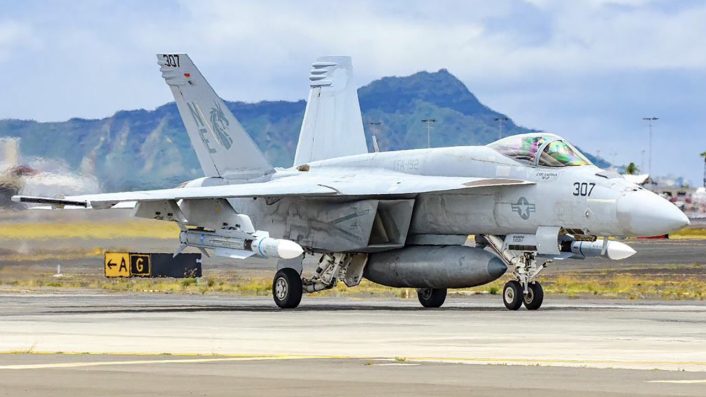
This is the 29th edition of the biennial naval exercise, recognized as the world’s largest, which kicked off on Jul. 1, 2024. Approximately 29 nations, 40 surface ships, three submarines, 14 national land forces, over 150 aircraft and more than 25,000 personnel will train and operate in and around the Hawaiian Islands during the exercise, which runs until Aug. 1.
Participating forces will “integrate and exercise” a wide range of capabilities, from disaster relief to maritime security operations, and from sea control to complex warfighting. Let us take a look at what distinguishes RIMPAC this year.
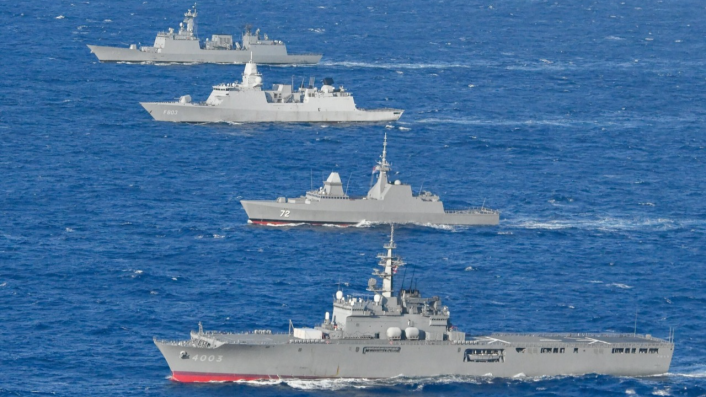
Torpedo hunts submarine
A release from the INDOPACOM (Indo-Pacific Command) quoted RAAF’s No. 11 Squadron Commander and Tactical Coordinator, Squadron Leader Tristan Hull, who said it was the “first time an Australian P-8A dropped this variant of the Mark 54 Lightweight Exercise Torpedo.”
“It is not very often that we get to drop exercise torpedoes. It’s almost certainly the highlight of a Tactical Coordinator’s career being able to do this, and on a live target is rare. So it’s pretty special for us to be here at RIMPAC this year. RIMPAC enabled training outcomes for the Squadron that they would not necessarily be able to achieve in Australia.”
Australia’s P-8A Poseidon entered the live fire area to the north of the Hawaiian Islands early Jul. 10 integrating with a US Navy P-8A. The two Poseidon aircraft conducted range surveillance in “a grid search pattern at low altitude to hunt down the exact location of the submarine.” An MQ-9A UAV flew above the P-8As to record the training exercise.
While the crews were given the submarine’s coordinates, the P-8A had to “establish organic tracking and attack criteria.” The crews first “dropped sonobuoys to determine the track of the submarine.” After establishing its position, course and speed, they derived a “solution” to meet their “attack criteria and appropriate weapon placement.”
Dropping a Mark 54 torpedo involves the tactical coordinator to “position sonobuoys appropriately” in the water, the acoustics operator to “interpret” that information, and the pilots to fly the aircraft efficiently before an attack solution can be derived in order to position the weapon to acquire the target.”
Each of the four Tactical Coordinators dropped a Mark 54. The torpedoes are capable of tracking, classifying and attacking underwater targets. Exercise torpedoes do not come into contact with the target and there is no explosion. After a predetermined time the torpedoes float to the surface and are retrieved by a helicopter for “assessment, reconfiguration and reuse.”
Drones for ship-to-ship transport
The run up to the RIMPAC saw the Arleigh Burke-class destroyer USS Curtis Wilbur launch and recover six VTOL drones for validating their use in logistical roles of transporting small supplies between ships. Conducting the experiment between Jun. 19 to Jun. 24, as a part of the JITD (Just In Time Delivery Effort), the autonomous UAVs performed ship-to-ship and ship-to-shore autonomous deliveries of medical supplies and critical parts.
The drones, currently being tested before the USN finalizes the requirements for a formal procurement through competitive bidding, are the Skyways V2.6 (or Blue Water UAS) and the Pterodynamics Transwing. The UAVs are expected to take the load off the larger MH-60 helicopters or V-22 tilt-rotors that are invariably pressed into service for small and medium-sized lightweight cargo. The Blue Water UAS features four rotors surrounding a tear-shaped body with a pusher propeller for forward flight. It also sports folding wings and an inverted V-tail, and boasts a range of 500 mi (805 km) and a 30 lbs (13.6 kg) payload.
The X-P4 Unmanned Aerial System takes off from the flight deck of USS Curtis Wilbur (DDG 54). These advanced, remotely operated vessels boost the power of our interconnected sensors, enhancing the capabilities of our multinational force 🚁#Innovation #PartnersIntergratedPrepared pic.twitter.com/oS3whA6F7B
— RIMPAC (@RimofthePacific) July 3, 2024
The Transwing has an unique design, with the two wings, carrying two engines each (four engines in total), able to completely fold up and rotate to transform from a quadcopter configuration to a standard monoplane-shaped airplane. The company describes it as a “dihedrally-folding wing system.”
Japan’s P-1 Maritime Patrol Aircraft emerges
The exercise also saw the JMSDF’s (Japan Maritime Self-Defense Force) generally elusive P-1 MPA (Maritime Patrol Aircraft) land at MCAS (Marine Corps Air Station) Kaneohe Bay in Hawaii on Jul. 3. The domestically-developed aircraft, considered broadly a counterpart to the US-made P-8 Poseidon MPA for its capabilities and roles, doesn’t appear in reports very often.
Japan joining the (air) action! ✈️ 🇯🇵 A Kawasaki P-1 from the @JMSDF_PAO arrived at Marine Corps Air Station Kaneohe Bay, Hawaii. #RIMPAC2024 #AirPower #PartnersIntegatedPrepared pic.twitter.com/txYwbiMija
— RIMPAC (@RimofthePacific) July 3, 2024
The Kawasaki P-1 took off from Kanoya Air Base on Jul. 1, with the facility’s public affairs also releasing a collage of images and a video of the aircraft, its crew and other personnel leaving for RIMPAC, with their families seeing them off. The low-wing, purposefully-developed MPA, flies on four locally developed IHI F-7 turbofan engines.
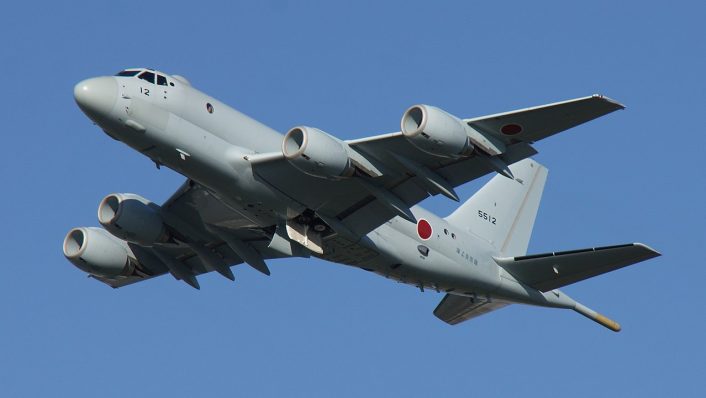
The plane first flew in Sep. 2007 and the JMSDF received the first two units on Mar. 27, 2013. Japan aims to replace about 80 of its P-3C Orion MPAs with about 70 P-1 aircraft, according to The Japan Times.
7月1日、令和6年度米海軍主催多国間共同訓練(RIMPAC2024)へ参加するため海外派遣訓練部隊としてP-1哨戒機と鹿屋航空基地隊員19名を多くの隊員と隊員家族で見送りました。#海自 #鹿屋 #航空 #海外派遣 pic.twitter.com/UndRBapoUK
— 海上自衛隊 第1航空群 (@jmsdf_1aw) July 2, 2024
Japan has long been trying to find international customers for the P-1. In a Feb. 2024 report, Italian Air Force officer Brigadier General Francesco Agresti identified the Kawasaki P-1 among the Boeing P-8A Poseidon and Leonardo’s C27J being considered for a new MPA and ASW (Anti-Submarine Warfare) platform.
Massive target practice ship
RIMPAC this year is also going to see one of the most massive targets to be used in the sinking exercise (or SINKEX), the decommissioned USS Tarawa amphibious assault ship. Commissioned in 1976 and decommissioned in 2009, she was stricken from the registry in Apr. 2024 and cleaned up before the exercise. The 820 feet long vessel was towed to Hawaii several weeks ago in preparation for being sunk.
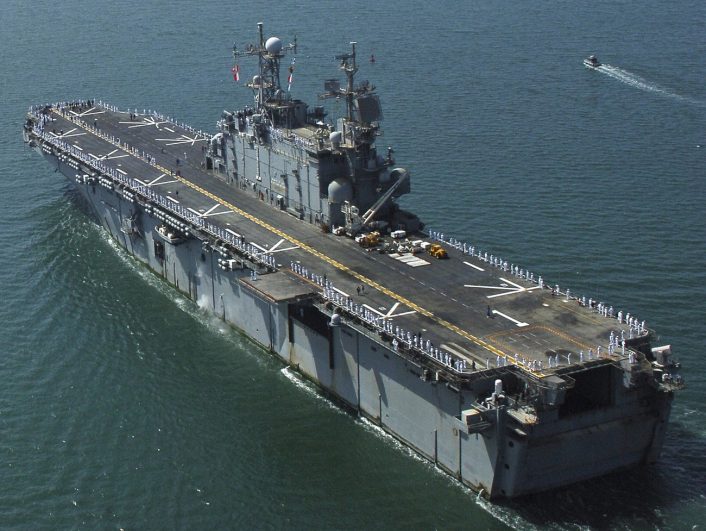
Stars and Stripes quoted Vice Adm. John Wade saying the ship was chosen since it could survive “multiple weapons” before it goes down. “It’s a large vessel, as you know, and it’s giving us an opportunity to conduct multiple serials, or multiple events, with multiple weapons. it gives us an opportunity to have a hulk that will last for hopefully a long amount of time, so we can get all of our drills through and successfully executed.”
HMAS Sydney spotted with four Naval Strike Missiles
Australian warship HMAS Sydney also sailed into Honolulu late in June sporting the Norwegian-made NSM (Naval Strike Missile) in double and quad box launcher setups. This was after the Australian government signed a contract with the developer Kongsberg in Jan. 2023, as a part of Canberra’s Project SEA1300 program to replace the Harpoon AShM (Anti-Ship Missile).
HMAS Sydney (DDG-42) with at least one four pack of @KOGDefence Naval Strike Missiles (NSM) coming into Pearl Harbor for RIMPAC.
For more on NSM in the RAN check out this article: https://t.co/J3JC3iUO1u
📸Petty Officer 1st Class Emily Casavant pic.twitter.com/QUnm3STeXF
— Ben Felton (@Benfdef) June 28, 2024
The NSM is emerging as a key air-launched surface-strike weapon. The US announced the acquisition on May 31, inking a $141 million deal with Kongsberg for the air-launched version, the JSM (Joint Strike Missile). The missile is slated to be integrated on its F-35As, since it is also compatible with the internal weapons bays of the stealth fighter.

